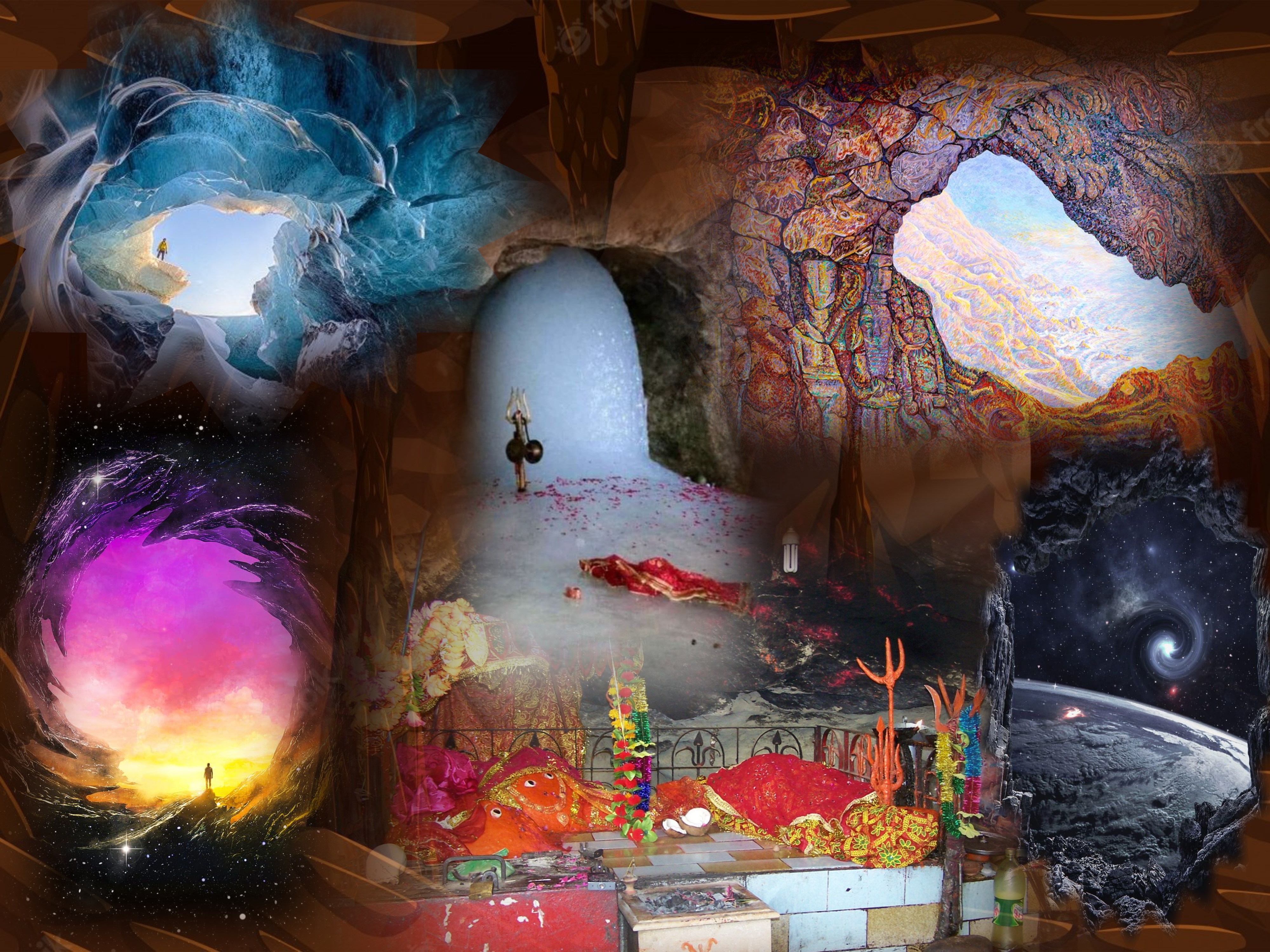- Visitor:21
- Published on:
Cave, Cosmos, and Consciousness Connection: The Origin of Sacred Space
India also has many natural caves from north to south and east to west, which early humans used as shelters and living spaces. The emptiness of the cave might have given them the expression of the sky (Aakasha Tattva), and the sky is the origin place for all celestial and non-celestial beings. Later, these caves became an example of another temple’s architectural development as the space in the temple was observed as Garbhagriha.

“If nothing else, surely the time has come to a stop the swinging pendulum that has fixated generations of philosophers, historians, and social scientists… bid farewell to the ‘childhood of Man’ and acknowledge that our early ancestors were not just our cognitive equals, but our intellectual peers too”.
(The Dawn of Everything)
Science is still looking for a clue as to how consciousness emerged in living organisms. Did the consciousness emerge with the evolutionary stage, or was consciousness there before the physical evolution? Today science has given us sufficient evidence that there is nothing special about being human; as a part of the earth system, humans are also one of the living organisms who share this living space—being human means having the power to imagine. This power of imagination has helped us move from one situation to another, a mental adaptation strategy to overcome variousproblems. Archaeology, an application dealing with the material culture of humanity, is used to think that prehistoric people, whom we called hunter-gatherers, only survived for their bodily fulfilment.Generally, in excavating prehistoric sites, one gets stone, bone and wooden tools, ornamental objects like animal teeth, beads made up of ostrich eggshells, etc. Theseare the material aspects of past societies, studied mainly by archaeologists.
Sapient Paradox
The origin of humankind remains one of science’s most challenging and intriguing uncertainties. The discovery of fossils, notably in Africa, and the DNA studies situate the emergence of Homo sapiens in Africa more than 150,000 years ago and the dispersal of our species out of Africa about 60,000 years ago. But when and how did the behaviours that we associate with modern humankind emerge? And, if the genotype was established 60,000 years ago or earlier, why did it take the new behaviours that accompanied the sedentary revolution of some 10,000 years ago so long to develop?
It introduces the new argument, sometimes called the “sapient paradox,” that some of the complex behaviours now associated with humans took a long time to develop even after the emergence in Africa of humans who were thoroughly modern in the anatomical and genetic senses. This is tricky territory because archaeologists had not agreed on when language first arose or when self-consciousness developed.[1]

Evidence for human behaviour performing certain rituals emerges in the archaeological record. One such is the discovery of a partial skeleton of a child datable to 78.3+4.1 BP from Panga yaSaidi, Kenya[2], wherein, as the excavator observes, ‘the torso appeared to have been wrapped in material that later disintegrated, “something like big leaves, like plants or perhaps animal skin, in addition to the digging of a pit and the apparent use of some sort of pillow for the head, suggested the “involvement of the community in putting the child in this particular position.’ The other examples include one possible burial in South Africa that dates to about 74,000 BP and another in Egypt to 68,000 BP. The modern humans and Neanderthals have buried their dead in Europe and the Middle East at multiple sites since 120,000 BP. The question arises here why only cave sites?
In traditional societies, death has not been seen as something terrible that happened to the deceased person; it was celebrated. Robert Wolff, in his book Original Wisdom[3], shared his experience with a Malay lady who was very sick. He brought her to the hospital against their family’s will, and how her (Sick lady’s) sister reacted when she came to know that her sister was admitted to the hospital. She told Wolff that the whole kampong knows that she is going to die, and that is why we are giving her all sorts of happiness; we were sharing her pain after her death, and we will bury her in the village cemetery so that we can visit her whenever we want. Her sister’s reaction tells us about how Malay people look at death and how the sickness of one member of the kampong is not a family affair but a community responsibility. Probably this kind of sensitiveness, one can also assume, for prehistoric people, where death was not seen as an individual’s loss. Still, it was a loss for the community, and death brought them closer to natural law and life flow.
This is the limitation for an outsider when they try to understand community dynamic social behaviour without having any emotional connection as a case study, the cognitive aspects of such communities, which are otherwise not preserved in the archaeological record. Therefore, visiting traditional communities that still follow the old ways of living is essential, untouched by modern education.These communities have many stories to share about their origin, their ancestor’s stories, myths, rituals they perform after the birth of a child, the death of a dear one, seasonal festivals, and cosmic events. The prehistoric communities did not record such aspects in detail. Still, they used walls of natural caves as a canvas to express their insights in different forms using linear patterns, animal forms (mythical as well as experienced), hunting scenesas well as gathering, fishing, etc.
Thus, the more obvious question arises: Is it possible to know more about these prehistoric communities? How did they perceive their world? As one believes in the ‘Out of Africa’ theory that humans dispersed from Africa to other parts of the world, they must have stored their experiences in their memories. They might have witnessed diverse landscapes, volcanic eruptions (Toba Eruption), encountered wild beasts, observed the sky, birth and death, diseased person, rainy seasons, cyclone, feeling the wind, seasonal fruits, leaves, flowers, animal behaviour, such encounters with nature must have brought him closer to nature. This deep connection with nature must have helped them to develop a co-existential relationship with the surrounding ecology in which they were a part and not superior to nature. The keen observation and curiosity to know and explore the surroundings gave them insights. This was passed on to the younger generation in the form of ethical teaching, the law of nature and how to have a harmonious relationship with nature and within the community. The elders in the community were responsible for healing and teaching the infants through their life experiences.
What could the close association between caves be for early humans?
Rock Paintings, Burials: Indicators of Human Consciousness
Natural Caves are probably nature-given houses for early humans. They might have developed a very emotional and affectionate attachment to caves. Australian Aboriginals, Bushman of Africa, still visit their ancestral caves to perform rituals, dream interpretation, or talk to their ancestors for personal and community guidance.They buried their near and dear ones and could share the same place simultaneously. The deceased person might become part of their community and will be a guardian for a family and the community. People started interacting with souls to ask questions before taking any critical decision, and they took blessings from their ancestors. In dreams, these souls interact with shamans (priests), making them aware of upcoming challenges. The shaman could be a healer, medicine man or enlightened soul in the community who can interact with souls and convey the message to the community.
India also has many natural caves from north to south and east to west, which early humans used as shelters and living spaces. The emptiness of the cave might have given them the expression of the sky (Aakasha Tattva), and the sky is the origin place for all celestial and non-celestial beings. Later, these caves became an example of another temple’s architectural development as the space in the temple was observed as Garbhagriha. Garbhagriha means adobe of consciousness in temple architecture; it symbolises the Shahashrar Chakra, the energy centre associated with the element of thought, connection to spirit, universal consciousness, enlightenment, wisdom, unity, and self-knowledge.In Natyashastra Garbha (गर्भ), One of the five segments (sandhi) of a dramatic play; —The sprouting of the seed, its attainment or non-attainment and search for it, is called the development (garbha).Thus, the term garbhagriha is a place of manifestation where everything emerges in its root (Mula). The symbolic meaning of Garbhagriha means emptiness, it could be corelated with womb or skull both are the place where creativity take place, in skull (seed as manifestation of idea) and in womb (seed as physical manifestation), both are important for creation.
Such deep insight probably was within the human consciousness starting from the prehistoric period itself; that is why humans consciously buried their loved ones in caves. Such phenomena can be observed all over the world.



Since the dawn of humanity, caves have played a significant role not only as the canvas for paintings but also as a place where everything merges with its original form (seed). This understanding emerged through profound experiences, which were places of shamans (priests) to perform their rituals and close association with womb-like structures from which everything has manifested. The origin of consciousness must have emerged from these caves, which became an integrated part of Indian architecture in the later period. Everywhere in the Indian subcontinent, such sacred caves arestill visited by people in search of ultimate reality.
Such archaeological evidence could help us to understand that our ancestors were not here only for survival, but they were very conscious about each action. Theirfocused observation enabled them to understand the natural law, and with the help of this understanding, they developed such intellect closer to nature. They were the ones who taught us the significance of storytelling and myth creation so that the upcoming generation can utilise that wisdom for their own as well as social and ecological wellbeing. The awareness that human is also a part of the earth’s system, not superior to any other natural creature, could be the most critical issue in such transmissions.
To be continiued…
[1]Solving the “Sapient Paradox” | BioScience | Oxford Academic (oup.com)
[2]Earliest known human burial in Africa | Nature
[3] Wolff, Robert. 2001. Original Wisdom: Stories of An Ancient Way of Knowing. Inner Traditions. Page no.39-40.
Center for Indic Studies is now on Telegram. For regular updates on Indic Varta, Indic Talks and Indic Courses at CIS, please subscribe to our telegram channel !
- 10 min read
- 0
- 0










